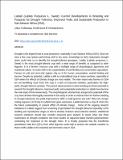| dc.contributor.author | Missanga, Julius | |
| dc.contributor.author | Venkataramana, Pavithravani | |
| dc.date.accessioned | 2025-06-26T06:07:13Z | |
| dc.date.available | 2025-06-26T06:07:13Z | |
| dc.date.issued | 2025-05-17 | |
| dc.identifier.uri | https://doi.org/10.1007/978-981-96-4112-3_14 | |
| dc.identifier.uri | https://dspace.nm-aist.ac.tz/handle/20.500.12479/3172 | |
| dc.description | This research article was published by Marker-Assisted Breeding in Legumes for Drought Tolerance, 2025 | en_US |
| dc.description.abstract | Drought is the largest threat to crop production, especially in sub-Saharan Africa (SSA). Since we have a few crop species performing well in dry areas , knowledge on their responsesto drought stress could help us to identify the drought-tolerant genotypes. Lablab (Lablab purpureus L. Sweet) is the most drought-tolerant crop with a wide range of benefits as compared to other legumes. It is a farmers' resource crop with a multiple range of physiological, agronomic and nutritional values. It excels well in the sustainability of soil fertility and conservation agriculture. Farmers in arid and semi-arid regions rely on it for human consumption, animal feeding and income. Despite its potential, Lablab is still an underutilized crop in many countries, especially in SSA where the effects of climate change are most visible. The main reason why farmers in SSA are not benefiting much from this crop is a lack of improved varieties, particularly the high-yield , drought-tolerant varieties. The present advancements in plant breeding and their potential in research for drought tolerance, improved yield, and sustainable production in Lablab have become the main topic of this review study. The morphological, biochemical, and genomic potential of this crop have all been thoroughly examined in this study in order to endorse them for further breeding in drought tolerancee and yield improvement. With a small genome size (367 Mb) and a longer coding sequence (1276 bp) to exhibit more gene expression, Lablab becomes a crop of choice for the future sustainability in present effect of climate change. . Some of the ongoing research initiatives in Lablab suggest more screening of germplasm for drought tolerance especially at the seedling and reproductive stages so that to develop moisture stress-tolerant varieties . Additional research initiatives should also consider advanced gene analysis to assess DNA and RNA expressions on drought conditions and more studies on sequence-based markers-polymorphism contrasting for responses to the drought stress. It is finally proposed that the transferred quantitative traits loci (QTL) from other legumes could help to achieve the suitable varieties so that to shift Lablab to the industrial and economic crop in SSA. | en_US |
| dc.language.iso | en | en_US |
| dc.publisher | Springer, Singapore | en_US |
| dc.subject | Research Subject Categories::NATURAL SCIENCES | en_US |
| dc.title | Lablab (Lablab Purpureus L. Sweet): Current Developments in Breeding and Prospects for Drought Tolerance, Improved Yield, and Sustainable Production in Sub-Saharan Africa (SSA) | en_US |
| dc.type | Article | en_US |

